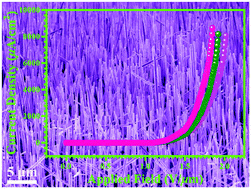Graphene/SiC heterojunction nanoarrays: toward field emission applications with low turn-on fields and high stabilities†
Abstract
Low turn-on fields (Eto) and high current emission stabilities are recognized as two crucial factors for the potential applications of field emission (FE) cathodes. In this work, graphene/SiC (G/SiC) heterojunction nanowire arrays were fabricated through catalyst-assisted pyrolysis of polymeric precursors. Aiming to explore advanced field emitters, G/SiC nanoarrays are designed to grow with a desired architecture including sharp tips, rough surface, incorporated dopants, and well-aligned configurations, which could fundamentally increase the effective emission sites, tailor the band gap structure, fully utilize the local field enhancement effect, and limit the shielding effect. The G/SiC emitters established exceptional FE properties with low and stable Eto of 1.10–1.12 V μm−1 when subjected to various anode–cathode distances, as well as a small current emission fluctuation of ∼3.7% over 5 h and high field enhancement factor up to 6383, which were comparable to the state-of-the-art ones previously reported, representing their totally excellent FE performance.



 Please wait while we load your content...
Please wait while we load your content...